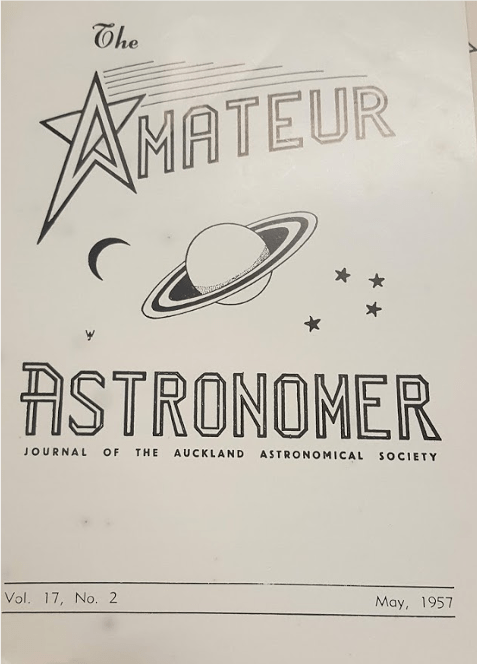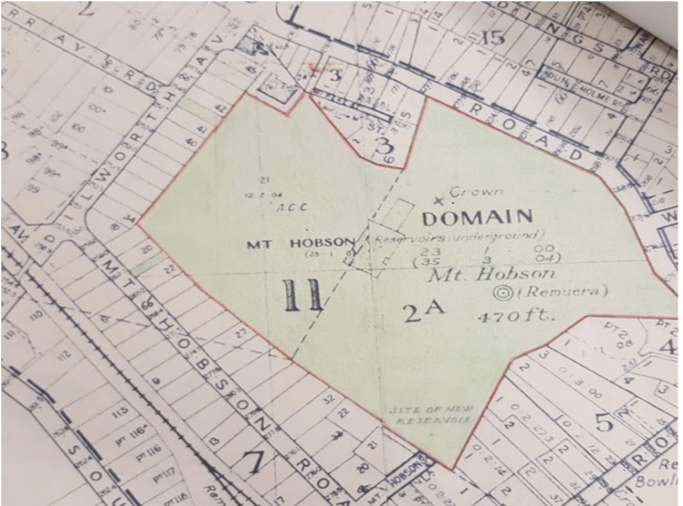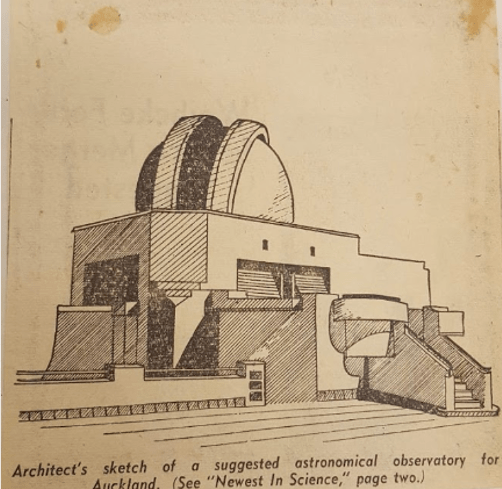Part Three
“Not in my Backyard” – The Construction of the Auckland Observatory
by Isabella Wensley*
Aucklanders have always had a special connection to the greenspaces that cover Tāmaki Makaurau. Each one is tied to the local population. Suburbs share the name of the nearest maunga (mountain) and each one is easily identifiable. Residents use the relatively untouched spaces as places of recreation, relaxation and memorialisation and have grown attached to the sight of the undisturbed summits. But as with any large population, there are controversies and differences in opinions in exactly how these spaces should be used and developed or whether they should be left alone.
The idea of Aucklanders having their own maunga and opposing views as to their function is reflected in the decades long quest of the Auckland Astronomical Society to find a site for Auckland’s first observatory. Today, the Stardome Observatory sits undisturbed in a corner of the Maungakiekie Domain, attracting large numbers of visitors most nights and quietly continuing its exploration of Auckland’s skies. However, the path towards its completion was not so smooth, due to the immense opposition launched by residents at each proposal to build an observatory on ‘their mountain’.

Cover of the Auckland Astronomical Society Journal from May 1957 that contained an article on Māori astronomy. Mayoral Office Correspondence Files, ACC 230 Box 1 Item 1e Record ID 84365, Auckland Council Archives.
The Auckland Astronomical Society was formed in 1923 as a group of voluntary amateur astronomy enthusiasts and operated out of a “shack” on Symonds Street, shared with members of the public and university students until this was demolished in 1946.[1] The Society began thinking about building a permanent observatory for Auckland in the early 1920s. While One Tree Hill likely wasn’t their first choice, the ever-hopeful Society suggested that the proposed obelisk be changed into an observatory at the summit which would both better serve the local community and honour the Māori race due to the “great part played by astronomy in the Maori life”.[2] This 1920s proposal was never seriously considered by the Cornwall Park Trust Board. Yet the Auckland Astronomical Society was seemingly ahead of its time in its desire to make clear the link with Māori astronomy, writing in one article, “we have a long history of astronomy behind us … at a date which is clouded by the lapse of time there was in this land a much wider and keener appreciation of the stars than is to be found today.”[3] Despite sometimes using language deemed unacceptable today, for example comparing Māori astronomers to “civilised astronomers”, it is clear the society was aware of and appreciative of the Māori history that preceded them.[4]
The search for an observatory site was ramped up in with the bequest of £7,000 by Mrs E.W Blackwell to cover the cost of a telescope for the new observatory.[5] Desperate to keep a hold of this promised money, the Society looked for a site with increased vigour. Initially, the Society seemed spoiled for choice in Auckland. There was no existing observatory to compete for space and the many volcanic cones and public reserves provided the clear space necessary to host the site. The Society first favoured sites such as Albert Park, the Domain, Mt Hobson and Mt Albert.[6] This was in 1953, and by 1960 all of these sites would be ruled out, either by official or residential opposition, or technical challenges causing the society itself to reject the location.
The Domain was the first to be seriously investigated and subsequently rejected. The Museum already housed a planetarium, so the proposal was to erect the observatory on the top level of the Museum building. It is difficult to imagine today how this would have looked – a huge concrete structure mounted on the classical style building. This was eventually rejected due in part to the difficulties with construction. Opposition was also mounted to this because of the perceived inappropriateness of putting an observatory on top of a war memorial, seemingly because it may have detracted from its function as a memorial or ‘lower the tone’ by creating a use for the reflective space.
Mt Hobson was next in line for the Society. Of all the proposed sites, this was the most favoured from the start. Mt Hobson provided a good flat surface, central location, trees to cover the structure and no disturbance from vibrations or construction. However, almost as soon as residents in the affluent suburb of Remuera got wind of the proposal, they shot it down.

Proposed plans for the Mt Hobson site. Town Clerk’s Department Subject Files, ACC 275 Box 376 Record 53-174 Record ID 460848, Auckland Council Archives.
Committee members visited the mountain one night and were met by “a band of 13 women and 10 men, residents of Remuera” protesting the development of the park as they wanted to keep it free for children to play.[7] Emphasis was placed by many letters to the editor on preventing the observatory from ruining the “unspoiled beauty” of the maunga. However, this concern did not extend past their Remuera mountain, as shown by one comment saying, “we do not mind where the observatory is placed, as long as it is not here in Remuera.”[8] Eventually, a petition was created opposing the observatory and with over 100 signatures, the committee admitted defeat.
Similar opposition was faced when the committee moved their attention to St Andrews reserve in Epsom. Cottoning on to the unpopularity of their plans, the committee planned to visit the site, rather suspiciously, unannounced and under the cover of darkness. But residents discovered the visits and again responded with opposition, saying that “the reserve was the only piece of open ground in the area and as such it should not be encroached upon.”[9]
By October 1960, the Society had been chased out of Mt Hobson, St Andrews Reserve, and the Auckland Domain. One place that was receptive to the cause was Mt Roskill with the local Board offering the site to the Society who unfortunately had to reject it due to technical impossibilities. However, finally after abandoning the Mt Roskill site, the One Tree Hill Domain Board took pity on the cause and offered a space in Cornwall Park. The site was announced with much excitement and acknowledgement of the “seven years of disappointment and frustration.”[10] Somewhat surprisingly there is little evidence of any residents opposing the location and certainly none to the same extent seen at other Auckland locations.

“Observatory for Auckland,” Auckland Star, April 28, 1953, Works Department Classified Subject Files, ACC 219 Box 150 Record 53-128 Record ID 418472, Auckland Council Archives.
Despite the excitement at finally finding a place to build, writings from the committee portrayed the One Tree Hill location as most definitely a last resort option. The advantages were listed cautiously as being “reasonably accessible,” having “reasonably dark skies” and possessing a “friendliness” which undoubtedly would have been crucial after years of opposition. Reflecting on the location, one past member stated, “at any rate we decided rightly or wrongly on the One Tree Hill Domain site” as despite its “serious shortcomings”, which remained unexplained, “we were welcome, and it was available.”[11]

Construction beginning on the Auckland Observatory dome. Auckland Council Archives, ACC 230 Mayoral Correspondence Files 1931-1961 Auckland Astronomical Society.
So, the Auckland Observatory found its home in One Tree Hill not because of any unique draw or advantage but simply because it was the only remaining option. The process of arriving at this location serves as a reminder of the controversies and disagreements that can arise from the usage of Auckland’s greenspaces. One letter opposing the Mt Hobson site summed this up as the idea that “pleasances and open spaces live dangerously” and “must be relentlessly defended against people who want to put them to practical use.”[12] But while the One Tree Hill Domain did ‘sacrifice’ a section of open space for a practical purpose, another perspective is that the advancement in scientific knowledge and public entertainment was worth it and even enhanced the use of that space. As one letter to the newspaper by B.J. Dunsheath noted, “the march of science cannot be stopped.”[13] The debacle of the Society neatly demonstrates the underlying tensions in the use of public space. Whereas residents, in an almost Victorian style, romanticised the empty greenspaces for the benefits it gave to children and families, the Society envisioned a scientific utilisation of seemingly idle spaces as a symbol of modernity and progress.
[1]“City once had an observatory, it was just a shack,” Auckland Star, July 10, 1956, Town Clerk’s Department Subject Files, ACC 275 Box 376 Record 53-174 Record ID 460848, Auckland Council Archives.
[2]Sir John Logan Campbell Papers, MS-51-313-1-23-1, Auckland War Memorial Museum – Tamaki Paenga Hira. Deposited by Cornwall Park Trust Board (Inc).
[3]R.A. McIntosh, “The Astronomical History of the Auckland Province – Part I: The Maoris,” The Amateur Astronomer: Journal of the Astronomical Society, 17, no.2 (May 1957), p.20, Mayoral Office Correspondence Files, ACC 230 Box 1 Item 1e Record ID 84365, Auckland Council Archives.
[4]McIntosh, p.20.
[5]Auckland Astronomical Society, The First Fifty Years: A Special Edition of the Journal of the Auckland Astronomical Society, p.22.
[6]“Astronomers Want City Observatory,” New Zealand Herald, April 24, 1953, Works Department Classified Subject Files, ACC 219 Box 150 Record 53-128 Record ID 418472, Auckland Council Archives.
[7]“Domain Site Proposed for Observatory ‘Don’t Put It Here,’ Say People of Remuera,” New Zealand Herald, September 9, 1956, Works Department Classified Subject Files, ACC 219 Box 150 Record 53-128 Record ID 418472, Auckland Council Archives.
[8]“Domain Site Proposed for Observatory ‘Don’t Put It Here,’ Say People of Remuera,” New Zealand Herald, September 9, 1956, Works Department Classified Subject Files, ACC 219 Box 150 Record 53-128 Record ID 418472, Auckland Council Archives.
[9]“Residents object to site suggested for observatory,” New Zealand Herald, June 1, 1960, Town Clerk’s Department Subject Files, ACC 275 Box 376 Record 53-174 Record ID 460848, Auckland Council Archives.
[10]“At Last Close to Site for Observatory,” New Zealand Herald, October 21, 1960, Town Clerk’s Department Subject Files, ACC 275 Box 376 Record 53-174 Record ID 460848, Auckland Council Archives.
[11]Auckland Astronomical Society, p.26.
[12]“Threat to Suburban Hilltop,” New Zealand Herald, September 22, 1956, Works Department Classified Subject Files, ACC 219 Box 150 Record 53-128 Record ID 418472, Auckland Council Archives.
[13]“Observatory Site,” New Zealand Herald, October 10, 1957, Town Clerk’s Department Subject Files, ACC 275 Box 376 Record 53-174 Record ID 460848, Auckland Council Archives.
